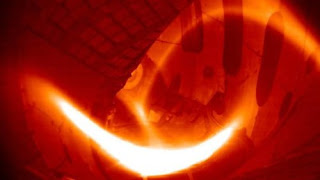 |
| The Reactor Wendelstein 7-X |
The newest experimental fusion reactor Wendelstein 7-X was successfully warmed up injected into his cell a small amount of hydrogen to a temperature of 80 million degrees Celsius, turning hydrogen gas into high temperature plasma. Most of the settings and modes of operation of the reactor were identified by German scientists at the end of last year, during the first run of the reactor in which the fuel used is gaseous helium. And the last event is the beginning of an extensive programme of testing and research in the field of thermonuclear fusion using the world's largest reactor type stellato.
We remind our readers that the construction of the reactor Wendelstein 7-X took almost a decade, and only in December of last year, it was launched for the first time. This complex plant is designed for high efficiency and for retention in a magnetic field of high temperature plasma for 30 minutes at a time. And if the idea of conceptual-type reactors stellato will be viable, these reactors may Herald the era of reliable and environmentally friendly fusion energy.
Since its first launch on 10 December 2015 scientists from the Institute of plasma physics max Planck (Max Planck Institute for Plasma Physics, IPP), where and is the reactor Wendelstein 7-X, produced about 300 inclusions. The main purpose of these events is the plasma cleaning and the removal of the top layer of the surface of the chamber using the plasma. Naturally, while these inclusions all the recording equipment was turned on and collected a lot of information about the processes taking place in the chamber of the reactor.
 |
| The Reactor Wendelstein 7-X |
"The successful switching of the reactor for production of hydrogen plasma is helium plasma demonstrated its full readiness to perform the next phase of the research programme" says Dr. Thomas Klinger (Dr. Thomas Klinger), - "Now we have in hand the main subject of our further research."
At the launching ceremony of the reactor Wendelstein 7-X was attended by German Chancellor Angela Merkel, who, after a 20-minute speech, and pressed the start button. The command from this button included 2 MW of microwave heaters that are turned a small amount of hydrogen gas in a dilute high-temperature plasma. "During startup, the plasma temperature was 80 million degrees, and the time of its Foundation a quarter of a second," says Dr. Hans-Stephan Bosch (Dr. Hans-Stephan Bosch), - "Such plasma parameters fully comply with all pre-calculations".
 |
| The Reactor Wendelstein 7-X |
Research this phase will continue until mid-March of this year. After that, the reactor chamber will be opened and technical personnel will install on the surface of the tiles from carbon, which will provide additional protection of the walls. In addition, will be installed in the device to remove impurities trapped in the chamber together with the fuel. After this modernization the reactor should heat the plasma to higher temperatures and hold it for a longer time, for 30 minutes if the power expended in heating the plasma in 20 megawatts.
The reactor Wendelstein 7-X, the construction of which spent 1 billion euros and one million man-hours, will never produce a single watt of energy. He, primarily, is designed to assess the suitability of the reactor type stellato for energy production on an industrial scale and to demonstrate the advantages of Steller reactors before tokamak reactors, which can operate in short-pulse mode.
No comments:
Post a Comment